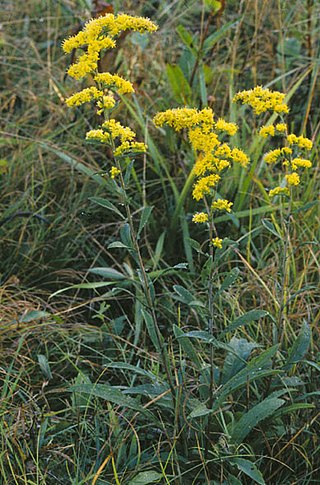
Goldenrod is a common name for many species of flowering plants in the sunflower family, Asteraceae, commonly in reference to the genus Solidago.

Symphyotrichum is a genus of over 100 species and naturally occurring hybrids of herbaceous annual and perennial plants in the composite family, Asteraceae, most which were formerly treated within the genus Aster. The majority are endemic to North America, but several also occur in the West Indies, Central and South America, as well as one species in eastern Eurasia. Several species have been introduced to Europe as garden specimens, most notably New England aster and New York aster.

Astereae is a tribe of plants in the family Asteraceae that includes annuals, biennials, perennials, subshrubs, shrubs, and trees. They are found primarily in temperate regions of the world. Plants within the tribe are present nearly worldwide divided into over 250 genera and more than 3,100 species, making it the second-largest tribe in the family behind Senecioneae.
Gundlachia, commonly called goldenshrub, is a genus of flowering plants in the family Asteraceae.

Laennecia or Laënnecia is a genus of flowering plants in the family Asteraceae. The plants are native to Mesoamerica, South America, and the southwestern United States. Common name is "horseweed."

Lorandersonia, commonly called rabbitbush, is a genus of North American flowering plants in the family Asteraceae.
Toiyabea is a genus of North American plants in the tribe Astereae within the family Asteraceae. The genus is named for the Toiyabe Mountains in the US state of Nevada.
Tonestus, common name serpentweed, is a genus of North American flowering plants in the family Asteraceae.
Xylothamia, the desert goldenrods, is a genus of flowering plants in the family Asteraceae. Until 2003, it was held to contain nine species of shrubs native to deserts of Mexico and the southwestern United States. However, it seems to contain at least two groups. Four species are related to Gundlachia and may be moved to that genus. Plants of the World Online class it as a synonym of Gundlachia. The relationships of the other five species is not quite as clear. All nine species do belong in the subtribe Solidagininae.
Mexerion is a genus of flowering plants in the tribe Gnaphalieae within the family Asteraceae. As of May 2024, the number of species accepted varies from one to three.

Nardophyllum is a genus of South American flowering plants in the tribe Astereae within the family Asteraceae.

Chrysogonum is a genus of flowering plants in the family Asteraceae. As of May 2024, two circumscriptions of the genus were in use. In the broader circumscription, the genus has a discontinuous distribution, with species native to eastern North America and Madagascar. In the narrower circumscription, the genus contains only species native to eastern North America.
Eurybia horrida is a species of flowering plant in the family Asteraceae known by the common names spiny aster and horrid herrickia. It is native to Colorado and New Mexico in the United States, where it occurs only in the Canadian River basin. It most often included in genus Eurybia.
Guy L. Nesom is an American writer and botanist.
Tomentaurum is a genus of Mexican plants in the family Asteraceae. Its species are native to northern Mexico.
Gundlachia triantha, the TransPecos goldenshrub or Trans-Pecos desert goldenrod, is a North American species of plants in the sunflower family. It is native to northern Mexico, with the range extending just over the Río Grande into western Texas in and near Big Bend National Park.

Eurybia glauca is a North American species of flowering plants in the family Asteraceae, called the gray aster. It is native to the western United States, primarily in Arizona, New Mexico, Utah, Colorado, and Wyoming, with a few populations in Idaho and Montana.

Eurybia kingii is a North American species of flowering plants in the family Asteraceae, called the King's serpentweed or King's aster. It has been found only in the State of Utah in the western United States.
Eurybia wasatchensis is a North American species of flowering plants in the family Asteraceae, called the Wasatch aster. It has been found only in the state of Utah in the western United States.








